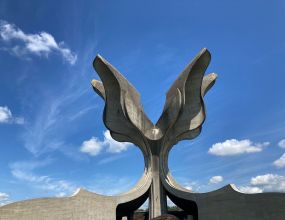
Unfortunately, people don't talk about the genocide of the Roma very often, which is why many people don't know about it at all. During the Second World War, the Ustasha, collaborators of the Nazis, killed the vast majority of Roma in the territories under their control. The Roma were sent to the Jasenovac concentration camp, located on the border of the territories of present-day Croatia and Bosnia and Herzegovina. Today, museum and memorial centers are located on the site of the infamous place.
In this place, the contrast between the tranquility and beauty of nature today and the horror of the events of the past, which remained only in the photographs in the museum, is striking. The ringing silence outside and the storm of emotions inside – that's the state you're in in this place.
One of the scariest exhibits of the museum for me were the drawings of the youngest prisoners of the concentration camp. The stories behind them come to life in interviews with survivors and witnesses of these events, shown in the museum. The numbers of Roma children killed in the camp are horrifying, and the Nazi separatist forces did not spare anyone.
Strangely enough, the book of reviews has become an unexpectedly significant component of the museum for me. Obviously, the existence of a place like Jasenovac in the past is not only the tragedy of this region, but I was amazed at how much this pain resonates with people from all over the world. The words of memory of those tortured in the walls of the concentration camp and expressions of hope that such events will never happen again are written in dozens of languages.
Visiting Jasenovac is quite a difficult emotional experience, but it is very important and necessary, because we cannot ignore the fact that such places existed in the past and the events that took place there. The voices of those tortured and killed behind the walls of the concentration camp will never be heard again, but their story must be told.
The genocide of the Roma during the Second World War remains one of the most overlooked tragedies of the 20th century. Visiting places like Jasenovac is a powerful reminder of the horrors that occurred and the countless lives. Remembering these events is not only an act of paying tribute to the victims but also a call to ensure that such atrocities are never repeated. By sharing these stories and keeping their memory alive, we take a small but vital step toward justice, awareness, and a more compassionate future.